Zhu Houcong - the Jiajing Emperor

Jiajing receives the accusing letter
A Troubled Succession

The Zhengde Emperor, the 10th Ming emperor period, left no sons and succession passed to Zhu Houcong (1507-1566), a distant cousin. The 11th Ming emperor with reign title of Jiajing ("Admirable Tranquility") was enthroned 27 May 1521 at the age of 15 and reigned for 45 years.
Zhu Houcong was the son Zhu Yuyuan (1476 - 1519), King of Xing and the fourth son of the 8th Ming Chenghua Emperor (r. 1465 - 1487).
Zhu Houcong was chosen by the able chief grand secretary Yang Qingho, who drafted a posthumous edict in the name of the Empress Dowager naming Zhu Houzong as legitimate successor. On 21 April 1521, barely two days after the death of the Zhengde Emperor, a delegation set out from the Forbidden City to escort the Prince of Xing to Beijing.
After a twenty day journey to Beijing from Zhongxiang, Hebei Province, Zhu Houcong ascended the throne. Grand secretary Yang had assumed that the emperor would accept his uncle, the deceased Hongzhi Emperor, and his aunt, the Empress Dowager Zhang, as his father and mother, respectively. But here Yang had seriously miscalculated.
Imperial Lineage
In June 1521 Zhu Houcong requested that his natural father and mother, King and Queen of Xing, be bestowed rituals and titles proper for an imperial lineage.
This immediately created a turmoil at the court. Most officials had already accepted the Jiajing Emperor and were not about to undo the entire succession process with the imminent danger of a palace revolt.
The grand secretaries, on the other hand, fiercely objected to elevating Zhu Houcong's family to imperial status and would rather see the new emperor resign. But the emperor was not inclined to abdicate and the grand secretaries could not well force him to do so on grounds of not being legitimate, because they were the ones that had selected him!
It came to a confrontation in October 1521 when Zhu Houcong's mother arrived from Zhongxiang to a city just outside Beijing. Here she learned that she would be received with rituals appropriate for a princess and not an empress dowager. She therefore decided to return home. When Zhu Houcong learned this he expressed his intention to abdicate and return to Zhongxiang with his mother.
Being at odds with most of the Ming court, the grand secretaries finally accepted a limited compromise and bestowed imperial titles to Zhu Houcong's father, mother and grandmother under the seal of the Empress Dowager. The emperor's mother now entered the capital as an empress dowager.
A fire in February 1522 aided the grand secretaries in having the emperor temporarily suspend his family's imperial status. The procrastination came to a final conclusion on 14 August 1524 when hundreds of court officials demonstrated against the emperor's edict to irrevocably reinstate his family's imperial status. The demonstrators were thrown in prison, many were beaten, some died and the rest were dismissed from their posts. The emperor's edict stood.
Such brutal handling of dissidents became the hallmark of the Jiajing Emperor's reign.
A Long but Mediocre Reign
Zhu Houcong was the only Ming emperor who believed in Daoism and huge sums were spent on Daoist temples and in finding the elixir of eternal life. To no avail however as he died aged 60 in 1566 -from poisoning!

Although he shunned state affairs, he at least appointed able ministers in the first part of his reign giving China the stability she badly needed.
In his last 20 years of reign however he came to rely upon corrupt officials, which led to widespread corruption and nepotism. Military aggression from Mongolia and incessant piracy by Japan and others in the south added to the decline of the Empire.
An official wrote him a letter accusing him of impoverishing his people, listening to slander, supporting corrupt officials and wasting the national resources.

An inferior gate -Dongbianmen
The letter quoted a public saying interpreting the emperor's name as meaning "every family (Jia) is empty (jing) and has no money". The letter threw Zhu Houcong into a rage and the official was imprisoned.
Following a siege of Beijing by Mongolians in 1550, Zhu Houcong in 1553 started the construction of the new, southern part of the Beijing city wall intended especially to protect the sacred places of "Temple of Heaven" and "Temple of Agriculture".
This is the section that constitutes the brim of the "high hat" that the former Beijing city walls look like from above.
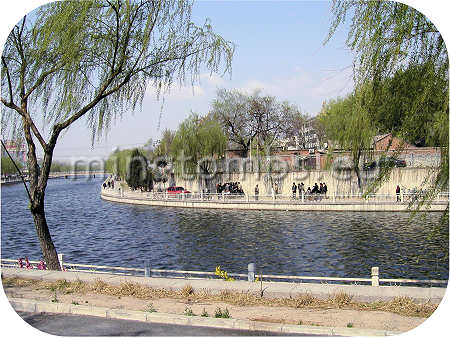
Southeast section of Beijing's moat from 1553
Lack of funds unfortunately limited the width and height of the wall and only allowed for city gates, which were inferior to those of the original Beijing wall of 1420-30. In the end, the originally planned total city encirclement had to be abandoned altogether with only the southern section finished.
The wall has since been dismantled and all the gates removed to straighten the road network. The good news is that entire moat around the southern part still remains. Beijing's 2nd ring road has been built alongside the moat and most drivers have the opportunity to enjoy the spectacular scenery that the moat offers.
It is certainly worthwhile on a warm spring day to take a stroll around the southeastern corner of the moat. Bring your camera.

Yongling layout
This mausoleum is huge and was constructed with material of the highest quality.
The ground layout was complex and different from most other Ming tombs Yongling had an additional front wall with a special triple front gate, which still stands.
Yongling even had an additional perimeter wall surrounding the entire mausoleum, but only the foundation of this wall is extant.
The "inner" entrance gate and its dividing wall have collapsed and only the stone foundation remains of the gate.
Also, only the stone platform of the main sacrificial hall is extant.
Yongling was divided into three distinct sections with physical walls, which stretched from perimeter wall to perimeter wall only broken by the interior hall and gate.
Tomb location:
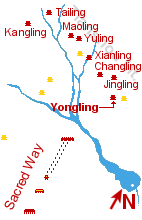
Google Earth:

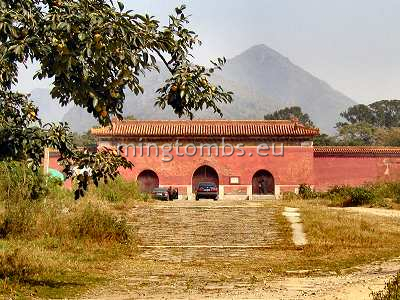
The entrance to Yongling by Mt. Tianshou
Prime Real Estate
The Jiajing Emperor was interred along with empresses Chen, Fang and Du in the eastern part of the Ming cemetery of Shisanling. The name of his mausoleum is Yongling.
Yongling is located at the foot of Yangcuiling ("Sunny and Emerald Ridge") of Tianshou Mountain.
Surprisingly, Zhu Houcong managed to locate a site for his mausoleum a mere 1-2 kilometers from Changling, the first and most prestigious mausoleum at the Ming cemetery even though another eight Ming Emperors before him had already secured themselves the best sites closest to Changling.
Construction commenced in April 1536 and lasted eleven years. It is noteworthy that the Jiajing Emperor's mausoleum was constructed during his own reign and not -as had been the case with earlier Ming emperors- by his successor.
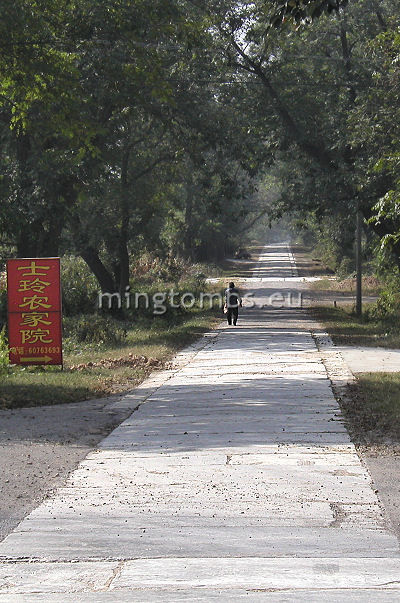
Extended Sacred Way
The tomb covers 250,000 square meters -far larger than those of his predecessors. Being an ardent Daoist, Zhu Houcong was quite obsessed with his mausoleum using only the best and most expensive materials.
His tomb had to be greater, bigger and more magnificent than any other of the Shisanling mausoleums save for Changling. And even then he couldn't help it but had an additional protective perimeter wall constructed just to outdo Changling!!
The mausoleum is almost oriented east-west, so in the following "north" and "south" will be used to denote the rear and front of the mausoleum, respectively, and "east" and "west" for the right and left sides, respectively.
Outer Sacred Way
It was not only in land size that the Jiajing emperor's mausoleum outdid his predecessors. He even extended his outer "Sacred Way" almost an entire kilometer "south" of the memorial stele in front of Yongling.
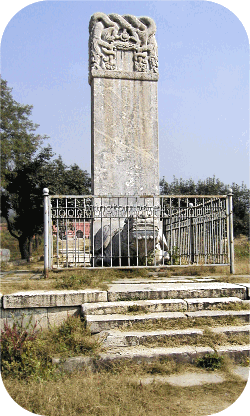
Memorial stele
This extended Sacred Way is still paved with with white stone slabs. It also crosses over not one, but two small bridges; the first with a single arch and the second, closer to the mausoleum, a double arch.
The outer Sacred Way ends at the memorial stele after having crossed a modern, small county roadway.
Memorial Stele
The memorial stele is the first structure greeting a visitor arriving on the county road. And what a stele!

Shrimp decoration
In line with Ming customs, the stele carries no inscription and its top is adorned with the traditional two entwining dragons.
Less common, the square stone platform on which the stele is erected carries a nice carving in each corner, a shrimp, a crab, a fish and a turtle, respectively.
The ocean and its creatures were associated with affluence and harmony, and water in general with life-giving, positive "waves", or "qi". One may wonder why other Ming mausoleums did not apply the same small feature to their stele foundations.
Perimeter Wall

Western perimeter wall
Looking up from the stele one can see the stone paved "Sacred Way" continue towards the triple gate a hundred meters up ahead.
Assassination !!
Zhu Houcong lived life dangerously. In 1542, eighteen of his palace girls attempted to strangulate him at night while he was asleep.
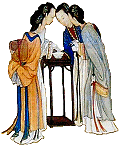 And had they bothered to learn how to tie a proper knot they might have succeeded.
And had they bothered to learn how to tie a proper knot they might have succeeded.
As it were, another palace girl alerted the empress to the ongoing murder and the attempt was foiled in time.
All eighteen girls were promptly executed by slow slicing and their families killed. However, the girl, who stood by the emperor, later became empress.
But on the way there one crosses yet another bridge and then, shortly thereafter, the foundation of a wall unexpectedly stretches in each direction. On the right side into an orchard and, on the left, into a grassy, but planted wilderness.
These are the remains of the extraordinary perimeter wall, which originally enveloped the entire mausoleum and offered an additional protection.
Similar auxiliary protective walls beyond the outer wall of the mausoleum precinct can also be found at some of the Ming consort tombs of Shisanling.
The front section west of the Sacred Way is by now a large stretch of pieces on top of the original foundation. The front section to the east has been cleared down to the foundation to allow better access inside the orchard.
The western and eastern sides of the perimeter wall runs in a straight line alongside the mausoleum side walls and then curves in a perfect semi-circle to the north, always equidistant to the tomb mound wall. [Ann Paludan draws the perimeter wall completely equidistant to the inner wall all the way, but the actual wall foundation does not support this].
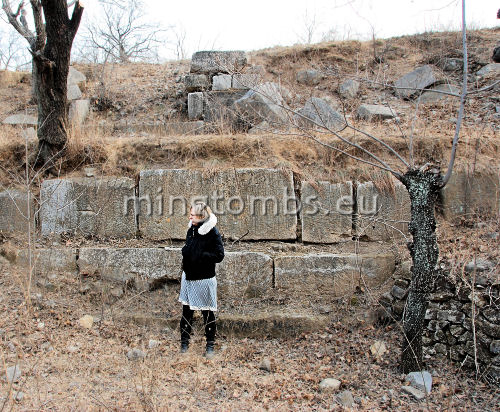
Drainage system in ravine
Midway on the western perimeter wall, and some 10 meters southwest of the wall proper, is a large, elaborate drainage structure. It appears somewhat collapsed, dilapidated and disused, but probably originally served as an integrated part of the otherwise excellent drainage system built into Yongling.
The structure opened up into a small ravine, which could accumulate excess water, lead it away from the mausoleum area and thus help preserving the tomb.
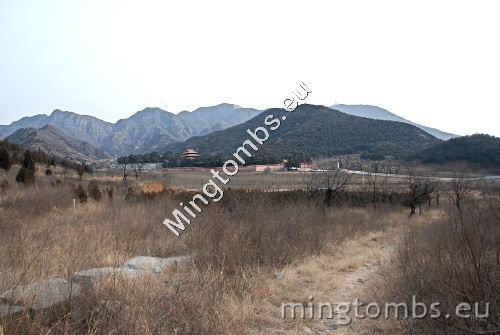
Deling seen from perimeter wall (left front)
From the top of the northeastern section of the rounded part of the perimeter wall one is rewarded with an excellent view of the nearby Deling mausoleum, the final resting place of the 15th, and second to last, Ming ruler, the Tianqi Emperor (1621 - 1627).
The eastern side of the perimeter wall is engulfed in one of the local villages and difficult to follow on foot, but one can pick up the trail again from the southeastern corner and back through the orchard to the Sacred Way in front of Yongling, where we started.
Yongling Triple Front Gate
Continuing north on the Sacred Way the path opens up onto a wide, brick covered space in front of the mausoleum wall.
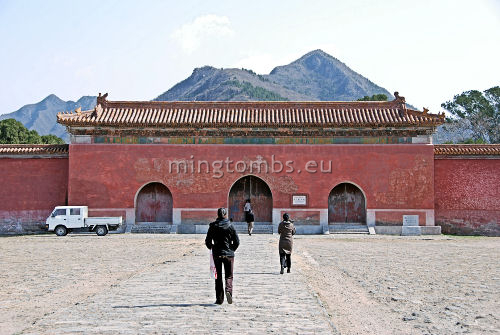
Yongling Triple front gate
The wall is in good condition and still carries a vermilion colored plaster coating on top of the large sized brick.
Access to the mausoleum proper can only be gained through the triple gate entrance.
This gate -and the outer wall- has obviously been restored and repainted. The usual yellow colored, glazed tile covered roof appears as good as new.
The restored wall and gate appear massive, solid and almost impenetrable, as they were intended to. The wooden doors have also been replaced and constitute both a visual and de facto barrier to entry. They send a clear message: No one shall disturb the Emperor's sleep.
Ling'enmen
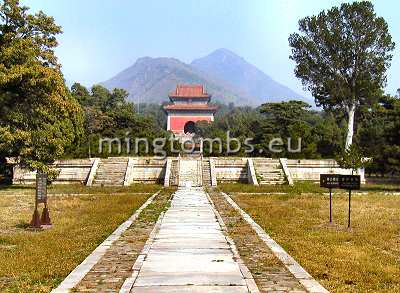
- Ling'enmen and Soul Tower -
Note the Lacebark pine right
The (inner) Sacred Way is still beautifully paved with large, white stone slabs. From the Triple Gate it leads straight to the Gate of Heavenly Favors, Ling'enmen.
A visitor would however be well advised to pause just inside the Triple Gate and take in the entire scenery from there.
The enveloping outer wall ensures a tranquil moment to enjoy the view of the large, open space between the two gates.
The view of the surviving Ling'enmen stone foundation is accentuated with the gorgeous lacebark pine tree on the right and the oak tree on the left.
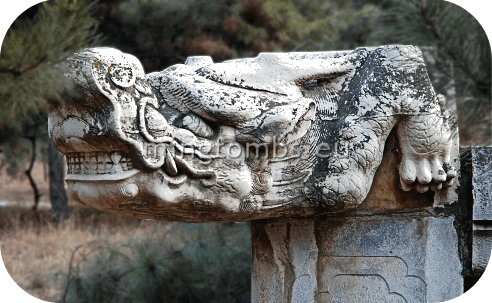
Large, corner gargoyle
The wooden structure and roof of Ling'enmen gate perished many years ago and only most of the sections made of stone are extant. Unfortunately, the balustrades have also gone missing despite being carved in stone. Balustrade parts have been stored in piles just inside the triple gate, but it is unknown whether these are the remaining pieces of the original structure or replicas to be restored.
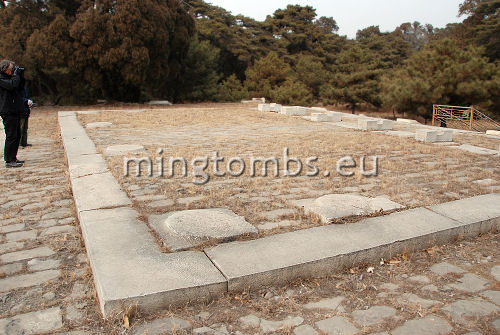
Foundation of Gate of Heavenly Favors
Large gargoyles shaped like dragon heads decorate each of the four corners of the stone platform and smaller ones decorate the sides.
Three marble staircases lead up to the stone platform both on the north- and south side.
The center staircase is adorned in the middle with the traditional marble slab. The staircase marble slabs of Yongling are however quite magnificent and break with earlier tradition by carrying the symbols of both the Emperor and Empress, the dragon and phoenix, respectively.
Ling'enmen gate stood in the center of the stone platform and based on the extant plinths we know that it was a three bay wide and one bay deep structure with an extended roof front and back.
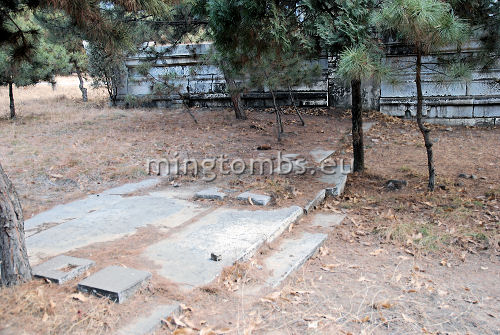
Service gate in the inner wall at Ling'enmen
Fortunately, the stone pieces which carried the door frame and wall are still extant and allow a good impression of what the gate originally must have looked like.
The remnants of a wall joining up to the middle of the west and east side of the stone platform are still extant. This dividing wall not only separated the fore court from the center court inside the mausoleum precinct, but extended all the way past the outer wall to the added protective perimeter wall.
A small, service door was built into the wall on both sides of the stone platform. The small stone step in front and the stone pieces for the doorposts are clearly visible today.
These side entrances allowed the tomb attendant to access the grounds for maintenance without having to open the main gates. The latter was only intended for use at the actual funeral and for the family members during the semi-annual rites in honor of the deceased.
Ceremonial Hall

- Ling'endian -
The Soul Tower and Mt. Tianshou in the rear
The center court on the north side of Ling'enmen contained the Ceremonial Hall and two smaller buildings, one on each side of the open area in front of the stone platform of the Ceremonial Hall.
Nothing but the stone foundations remains of the side buildings. The buildings were probably the traditional sacrificial kitchen and the changing hall. The latter doubled up as a storage for various accessories used in the semi-annual rites.
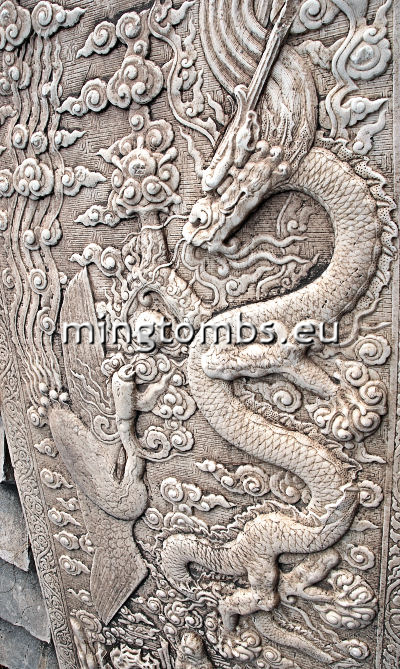
Phoenix and dragon in play
As with Ling'enmen, the wooden structure of the Ceremonial Hall is gone as are the marble balustrades, but the rest remain in good condition.
The stone platform is quite large with the somewhat smaller hall itself set in the center rear. The rectangular platform has a large, square extended section in front and not just the usual three, but a total of five stone staircases lead up to the extended platform surface, three in front and one on each side.
The marble Danbi stone in the center staircase is identical to those used for Ling'enmen. The stones have ocean and mountains at the bottom and at the top section among swirling clouds, a phoenix and a dragon with a pearl between them.
The side staircases carry no particular decorations.
Similar with Ling'enmen platform, the hall platform was equipped with gargoyles shaped like dragon heads to drain rain water. And, again, the corner ones were substantially larger than those on the sides.
The ceremonial hall stood on a further elevated stone platform at the rear of the main platform and was a five bay wide and three bay deep building based on the extant plinths. This was the standard size of a ceremonial hall in a Ming cemetery.
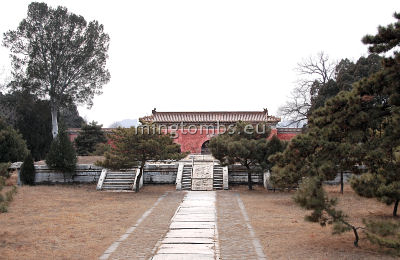
Ling'enmen as seen from atop Ling'endian
The Ceremonial Hall had a single entrance in the front (south), the stone pieces for the doorposts still extant. The hall had no openings at the sides or at the rear.
The fact that there was no door in the rear of the hall raises the interesting question of why then there was a wide staircase -even with a beautifully decorated center marble slab- at the back of the platform? Ann Paludan speculates, and probably correctly, that this superfluous staircase was built there for symbolic reasons (Paludan, p.125). It is also likely that it was perceived to augment harmony by creating symmetry.
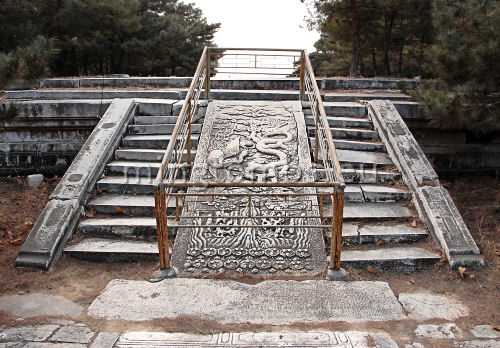
The superfluous staircase at the back of Ling'endian
Of course these stairs come handy today for a visitor crossing the platform, but that was hardly intended or foreseen back in 1536.
As is the case of Ling'enmen, walls extended from the stone platform all the way past the inner wall out to the outer perimeter wall. Service doors in the walls on either side of the platform ensured access to the rear and final section of the mausoleum.
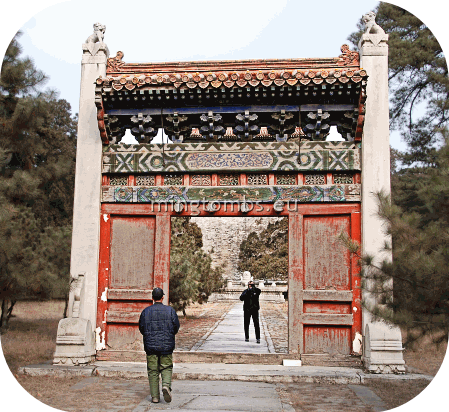
Double pillar gate
These walls in essence replaced the traditional dividing wall which would usually be placed some 10-15 meters behind ("north of") the Ceremonial Hall. Such wall would then be equipped with a larger, triple door gate, the center door being larger than its side sisters for passage of the Emperor's or Empress' body.
Lingxingmen
The protective screen door -Lingxingmen, or "Double Pillar Gate"- still has its two pillars with a Qiwen and Qilin on top, its wooden door and the doorsill.
The woodwork is in fairly good condition and has been restored in the not too distant past, say sometime late in the Qing dynasty (1644 - 1911) or in the early period of the Republic.

Sacrificial altar
The paint is peeling off and the decorative colors have faded on the crossbars, but the "roof" tiles still carry their imperial yellow coloration and are mostly intact.
Sacrificial Altar
The altar, which lies next on the Sacred Way, has four of the traditionally five vessels; one of the incense burners are missing.
It is hard to determine whether these pieces are the genuine originals or later replicas, and maybe it really doesn't matter.

Soul tower
The altar as well as the pieces are beautifully decorated, Various symmetric symbols adorn the altar stone on all four sides, and the vessels are similar to those normally used in the early 1500s.
Soul Tower
Minglou -or the "Soul Tower"- is very different from that of all the previous Ming mausoleums.
The tall foundation, covered by the usual enlarged, gray Ming brick, is larger than normal, and just a tad smaller than Changling. The foundation does not have the usual arched tunnel through to the small crescent shaped courtyard. In fact, Yongling does not even have a courtyard between the Soul Tower and the tomb mound.

Staircase alongside the tower
The entire "Square City" rests on a slightly elevated stone platform with three simple, undecorated staircases on the "south" side, one in the center and one close to each of the sides.
To access the tower one must instead of the tunnel use one of the stairways on either side of the tower foundation. Each of the stairways had a door, which however is no longer extant. The stones with holes for the door poles are however still extant and clearly visible.

Exquisite stones in the battlements
The stairways leading up to the tower have crenellated battlements. The merlons are made with incredibly fine stones, boasting finely polished and colored patterns of granules or "veins". These stones testify to the extreme high quality of material and workmanship used in the construction of Yongling.
The staircases end in the pathway on the rampart, which circles the tomb mound. An access way with slanted stones (to get purchase when walking up and down) lead further up to the soul tower.
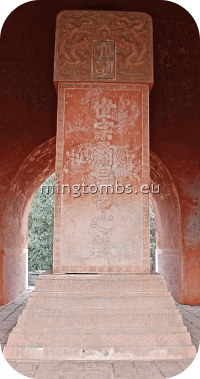
Stele inside
the Soul Tower
Having been restored at some time, the tower is in good condition. The construction sustains the impression of high quality one got from the polished merlons on the staircases.
The double-eave hip and gable roof still has its yellow glazed tiles intact and the wooden plague with the tomb name of Yongling is still in place on the "south" side.
Openings on all four sides lead into the center chamber, which contains the memorial stele.
Memorial Stele
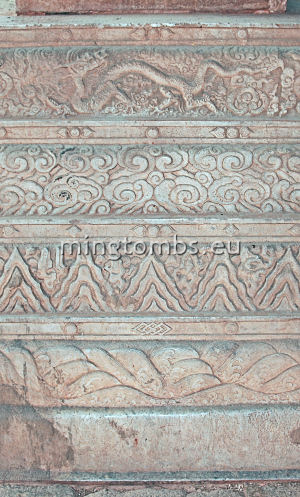
Stele base with five layers
The stele rests on five layers of decorated and colored stone slabs. The base one is undecorated, the one above is adorned with ocean waves and the next one up with mountains. Swirling clouds are chiseled into the fourth one and the top slab is decorated with dragons, symbolizing the Son of heaven, the Emperor.
The inscription on the stele reads "The Tomb of Respected Shizong Emperor" (Paludan, p. 126). Shizong was the temple name of the Jiajing Emperor.
The top section of the stele is adorned with the usual two dragons playing with a pearl hovering between them. The two inscribed signs read "Great Ming", also in line with tradition.
Tomb Mound
The "Precious Mound" is completely circular and has a wide walk path on the outer rampart.
The battlements are crenellated, but apart from the section closest to the Soul Tower, many of the merlons have fallen off or been dislocated and are piled up alongside the path waiting to be put back in place (?).

Path around tomb mound -note the displaced merlons
The inner wall has an opening from the path on either side of the Soul Tower foundation. The openings allow free access to the tomb mound proper.
The mound itself slopes upwards to a small cone in the center. the mound is heavily overgrown with evergreen trees, as evidenced by the Google map above left.
Trees have long since penetrated many parts of the battlements and pushed out the stones covering the tomb mound.
Interestingly, the Jiajing Emperor was not the first occupant of his mausoleum. This doubtful "honor" was bestowed upon Empress Fang.
Tomb Occupants

Trees penetrate the wall
All in all, four people are buried in Yongling; The Jiajing Emperor himself and empresses Fang, Chen and Du.

Empress Xiaojiesu
(1508-28)
Empress Chen, formally Empress Xiaojiesu, a native of today's Daming, Hebei Province, was the first wife of Zhu Houcong. She was born 1508 as Lady Chen to father Chen Wanyan (mother unknown) and entered the palace as a consort and Empress in 1522, but the emperor did not take a liking to her.
She passed away after a miscarriage caused by the rage of Zhu Houcong in 1528 and was interred in Aoeryu, Tianshou Hill. Her remains were reburied in Yongling in 1566 at the accession of the Jiajing Emperor's successor.
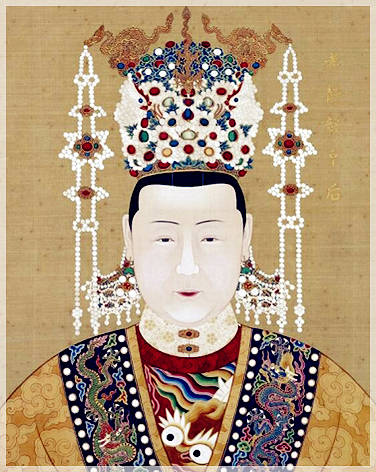
Empress Fang (1516-47)
formally Empress Xiaolie
He married his second wife, Empress Zhang, in 1528. She was the daughter of a member of the imperial guard. The emperor deposed her without any stated official reason in 1534, but unofficially because of family infighting. She died in 1537.
Lady Fang became Zhu Houcong's third wife. She was from Yingtianfu - today's Nanjing, Jiangsu Province. Born 1516, her father was Fang Tai, Marquis but her mother was unknown.
She entered the court in 1531 as Virtuous Consort, a third ranking imperial concubine. She was never destined to sleep with the emperor as he refused to have intercourse with any girl older than 15, but a chance and very positive meet between the two made him promote her to Empress in 1534.
It was Empress Fang who sounded the alarm at the assassination attempt in 1542 (see separate fact box). Even though she saved his life, he never forgave her that she had his favorite concubine Duan, whom he was sleeping with that night, executed along with all the assassins.
When she was trapped in a palace fire in 1547 he did not allow the eunuchs to save her and she burned to death. Still, he allowed her a funeral proper for an empress in Yongling, which had just been completed. Thus, she became the first tomb occupant.

Empress Dowager Du
Lady Du was born in Shuntianfu, present-day Daxing County, Beijing, to father Du Lin, Count of Qingdou, and mother, Countess of Qingdou. Her year of birth not recorded.
She became an imperial concubine of low rank in 1530 but was promoted to Joyful Imperial Concubine already in 1531 and to Joyful Consort in 1536. She was bestowed the title of Empress Xiaoke after she gave birth on 4 March 1537 to Zhu Zaihou, the Heir Apparent and later Longqing Emperor.
She died in 1554 and was buried at Jinshan Hill. When her son ascended the throne in 1566 he posthumously gave her the title of Empress Dowager Du and had her remains transferred to Yongling along with those of Empress Chen.
The mausoleum is not accessible to the general public. It has allegedly not been disturbed by grave robbers and remains unopened.